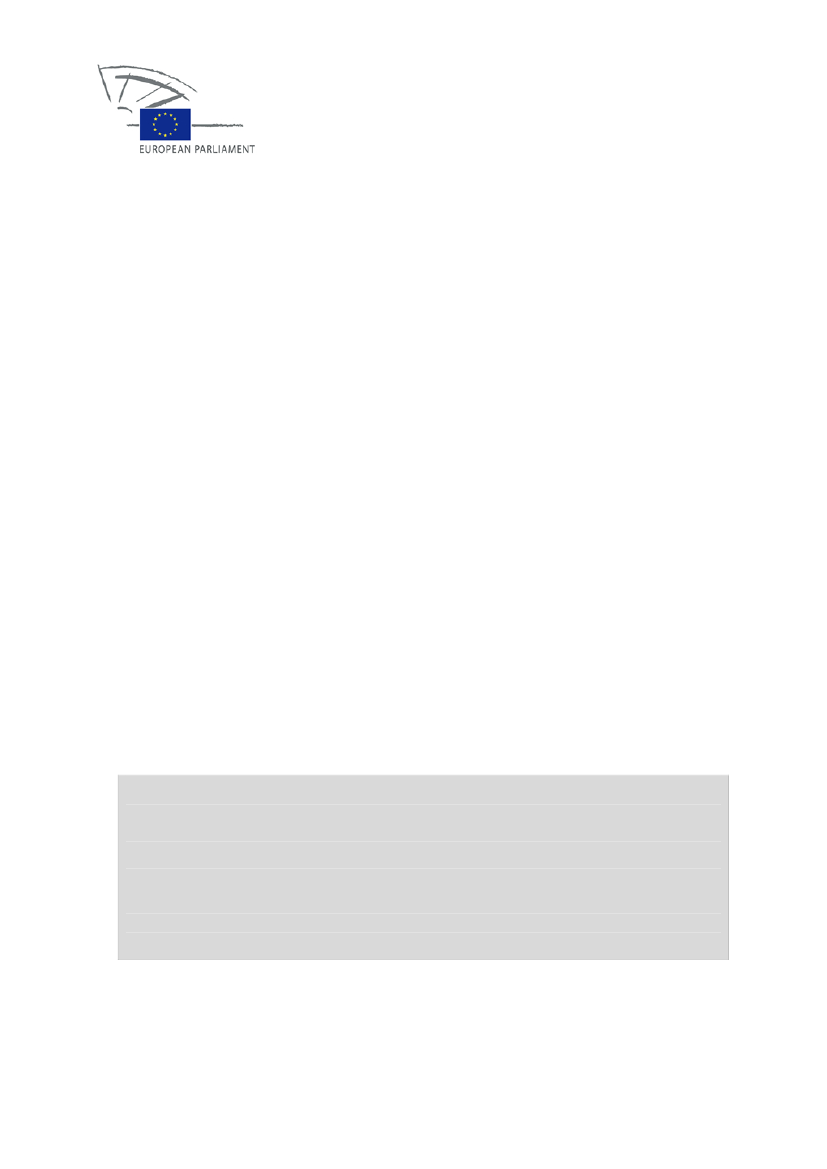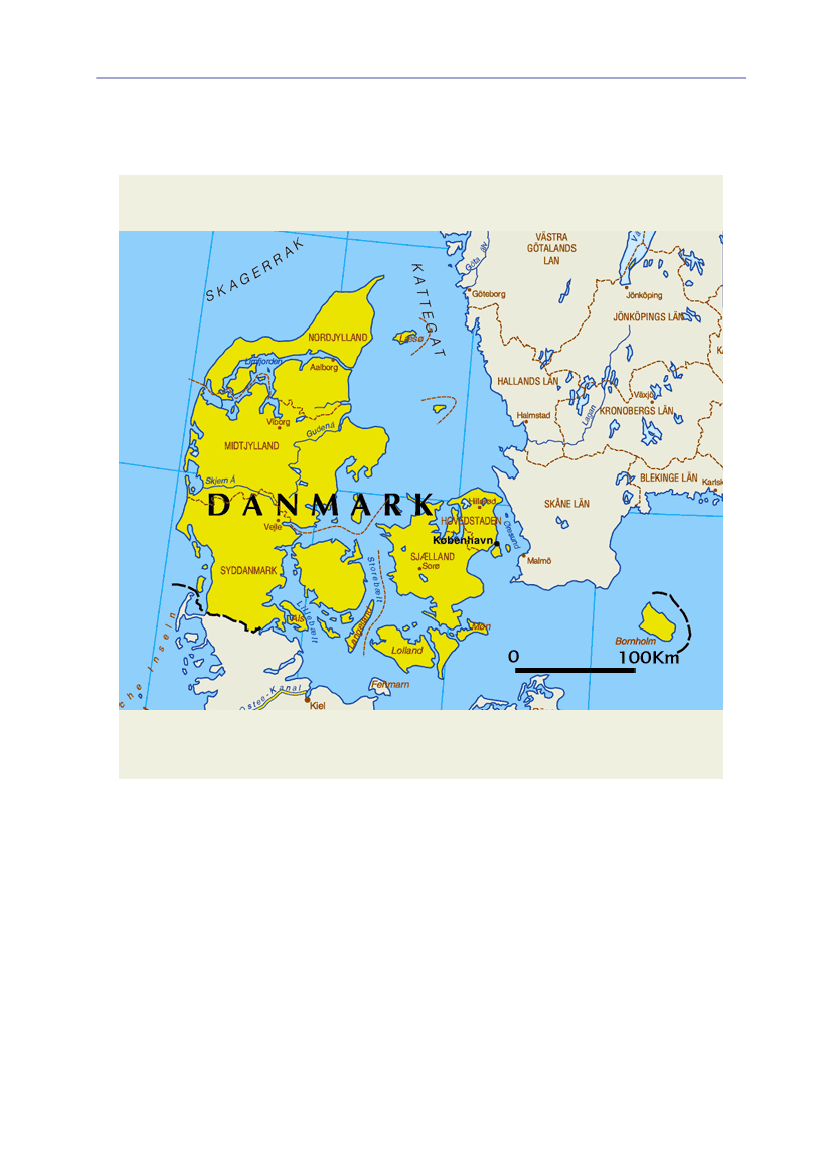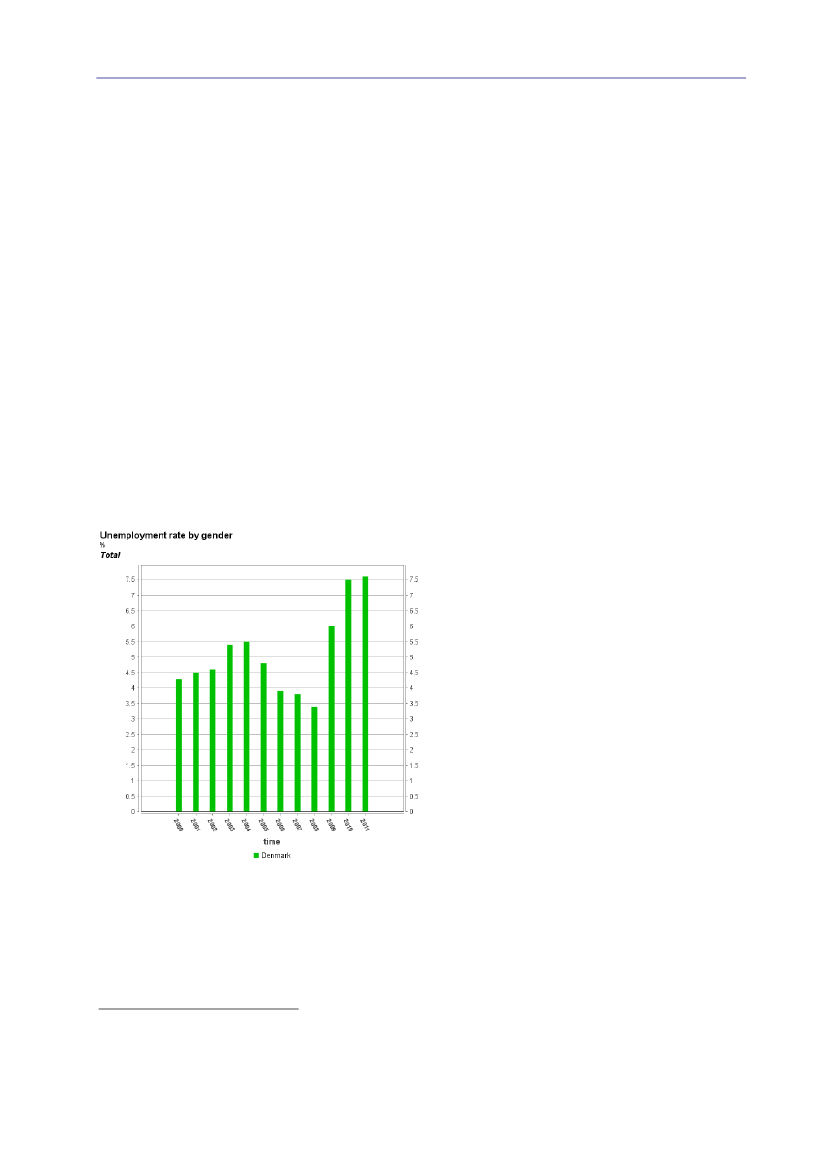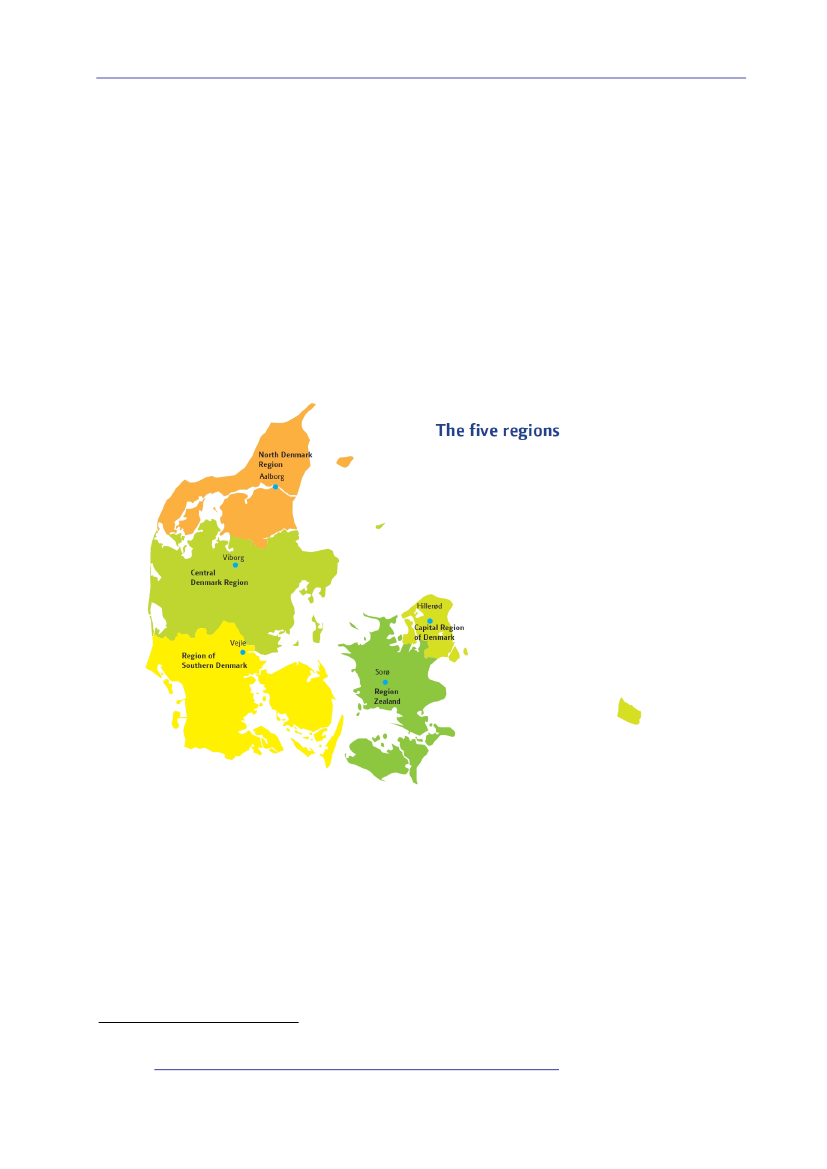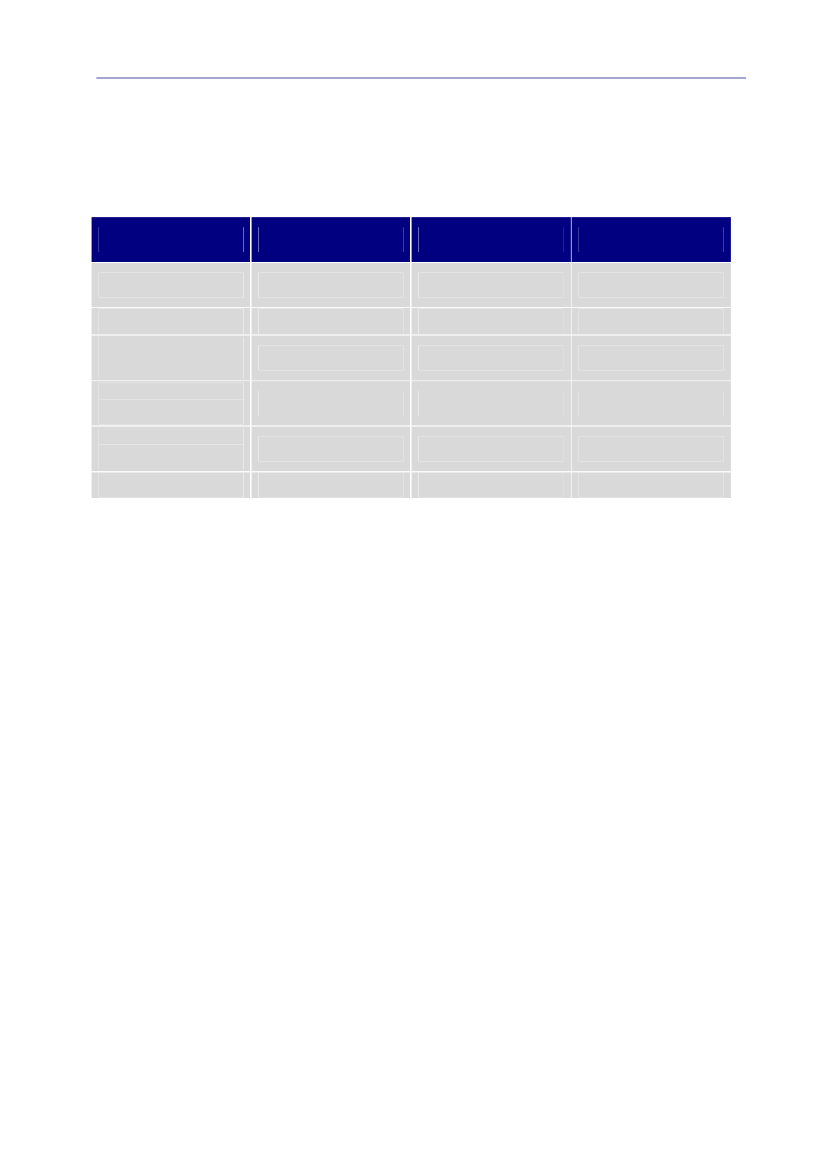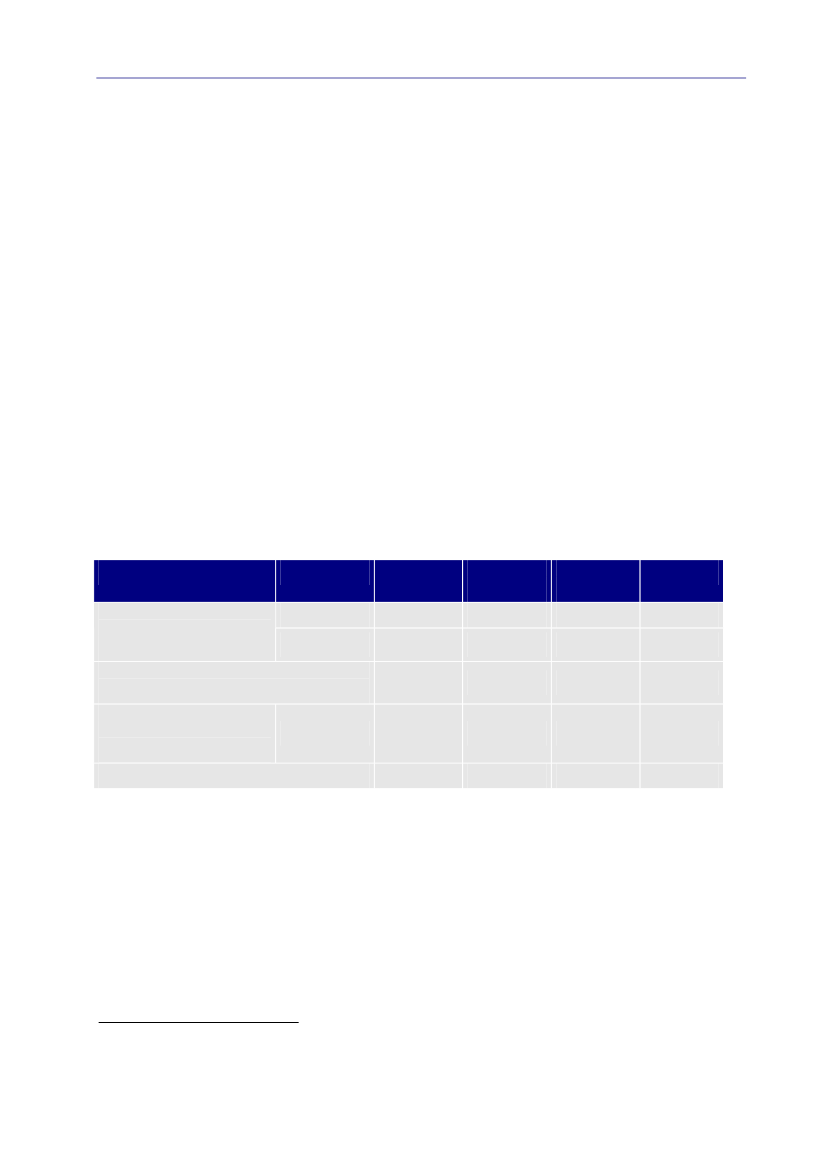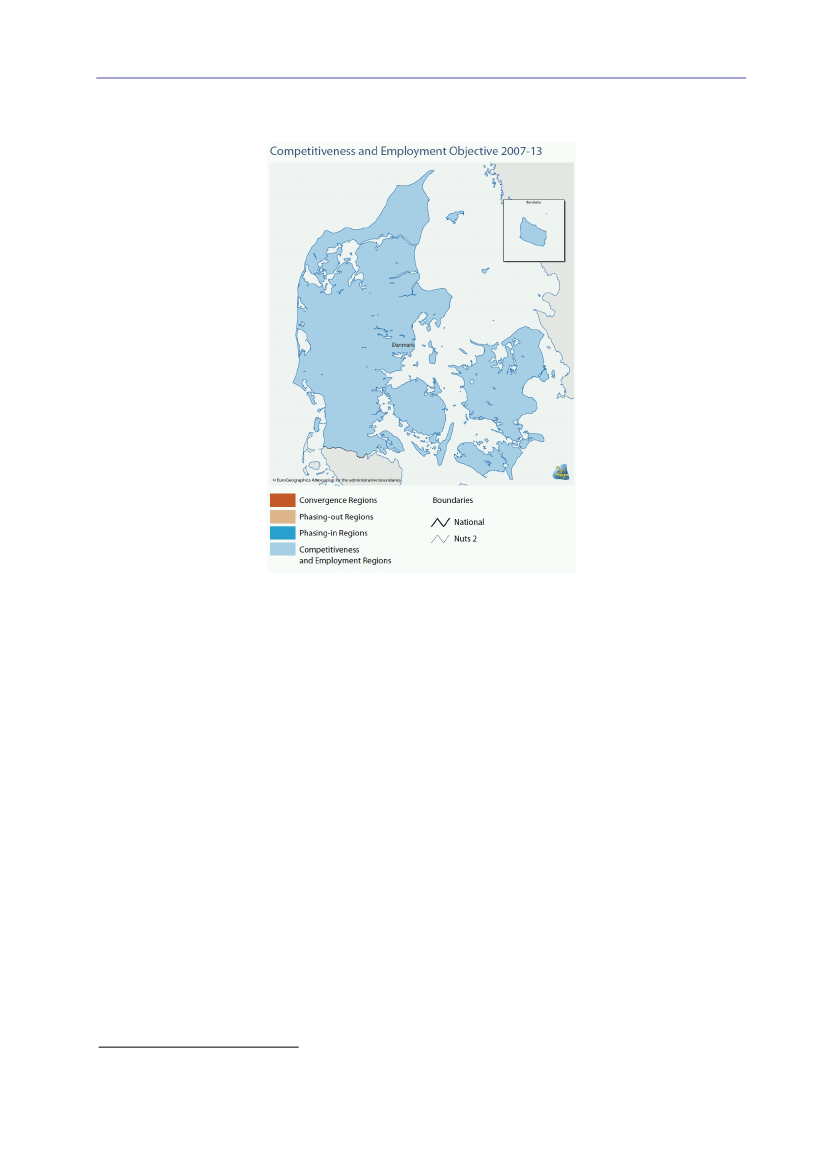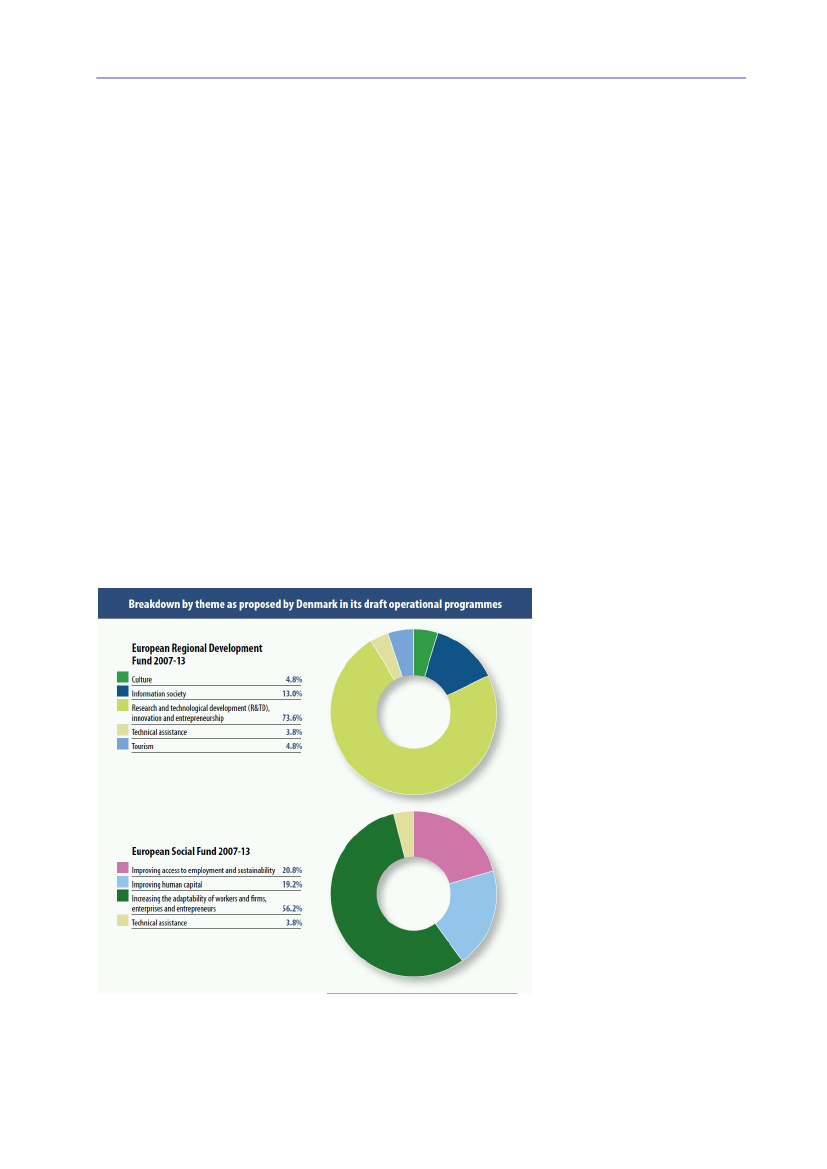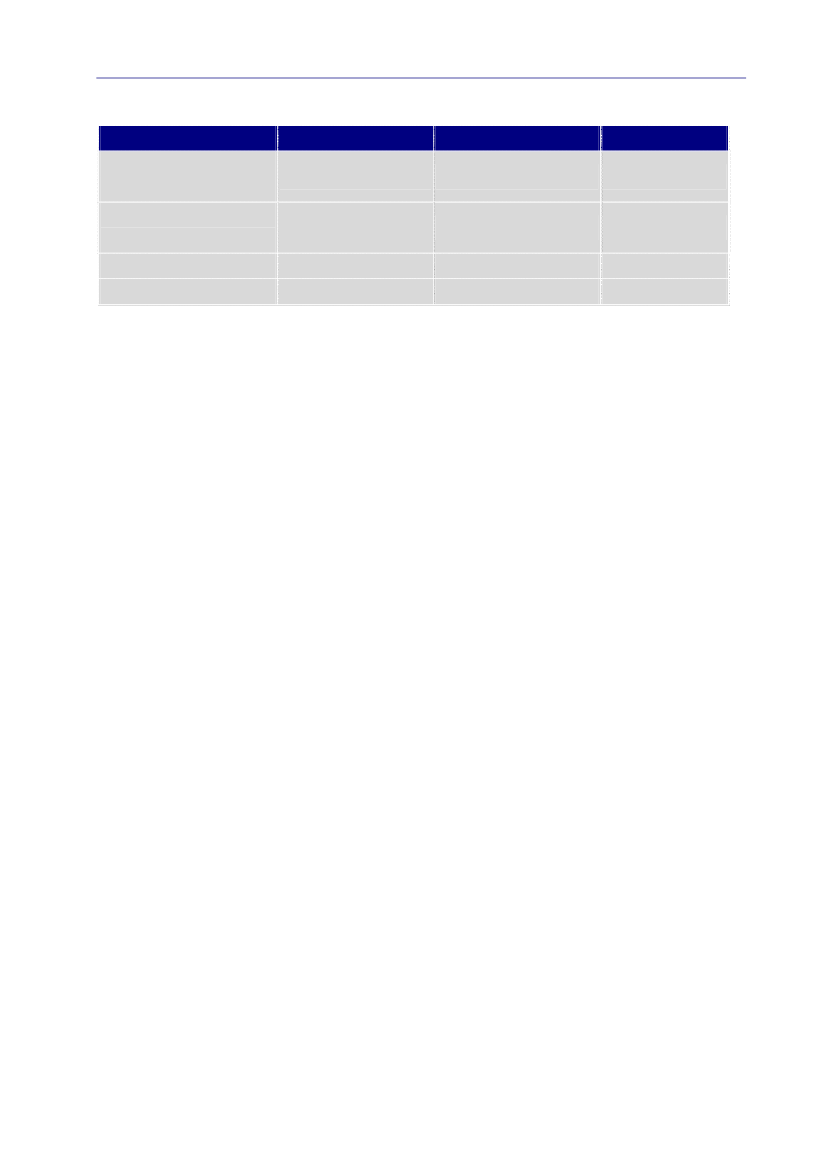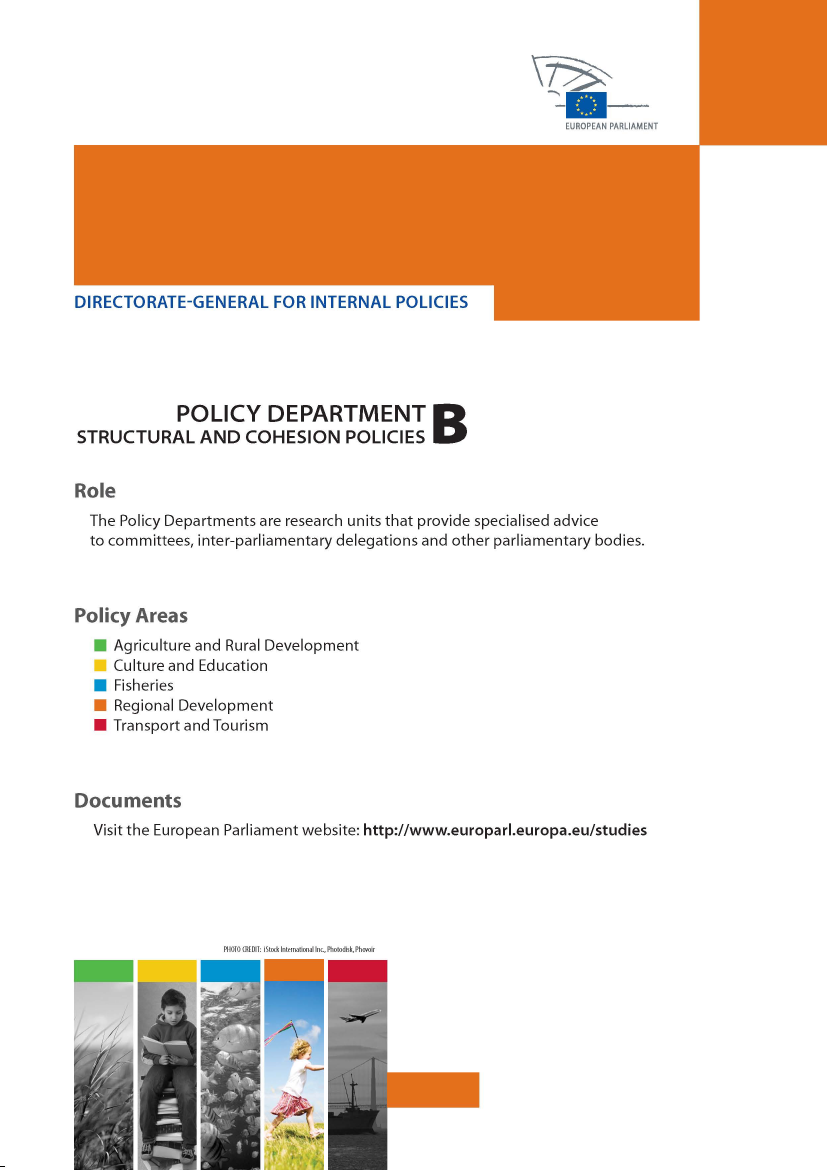Erhvervs-, Vækst- og Eksportudvalget 2011-12
ERU Alm.del Bilag 240
Offentligt
DIRECTORATE GENERAL FOR INTERNAL POLICIESPOLICY DEPARTMENT B: STRUCTURAL AND COHESION POLICIES
REGIONAL DEVELOPMENT
ECONOMIC, SOCIAL ANDTERRITORIAL SITUATION OFDENMARK
NOTE
This document was requested by the European Parliament's Committee on RegionalDevelopment.
AUTHORMarek KołodziejskiPolicy Department B: Structural and Cohesion PoliciesEuropean ParliamentB-1047 BrusselsE-mail:[email protected]
EDITORIAL ASSISTANCEMs Lea Poljančić
LINGUISTIC VERSIONSOriginal: ENTranslation: FR.
ABOUT THE PUBLISHERTo contact the Policy Department or to subscribe to its monthly newsletter please write to:[email protected]Manuscript completed in March 2012.Brussels, � European Union, 2012.This document is available on the Internet at:www.europarl.europa.eu/studies
DISCLAIMERThe opinions expressed in this document are the sole responsibility of the author and donot necessarily represent the official position of the European Parliament.Reproduction and translation for non-commercial purposes are authorized, provided thesource is acknowledged and the publisher is given prior notice and sent a copy.
DIRECTORATE GENERAL FOR INTERNAL POLICIESPOLICY DEPARTMENT B: STRUCTURAL AND COHESION POLICIES
REGIONAL DEVELOPMENT
ECONOMIC, SOCIAL ANDTERRITORIAL SITUATION OFDENMARK
NOTE
AbstractThis Note provides an overview of the Danish economic, political andadministrative framework for EU Cohesion policy, as well as its National StrategicReference Framework for the period 2007-2013.The paper gives also an insight into the Danish position on the future of Cohesionpolicy and the priorities of the EU Presidency from 1 January - 30 June 2012.The Note has been prepared in the context of the Committee on RegionalDevelopment's delegation to Denmark, March 2012.
IP/B/REGI/NT/2012_01PE 474.536
March 2012EN
Economic, social and territorial situation of Denmark
TABLE OF CONTENTSLIST OF ABBREVIATIONSLIST OF FIGURESLIST OF TABLES1. KEY FACTS AND FIGURES1.1. Political and governmental structures1.2. The economy
57791012151518191920222324252527293133
2. INSTITUTIONAL AND ADMINISTRATIVE FRAMEWORK FOR EUCOHESION POLICY2.1. Administrative Division of Denmark2.2. Structural Funds Management
3. EU COHESION POLICY IN DENMARK 2007-20133.1. Objectives and Funds3.2. NSRF and Operational Programmes3.3. European Social Fund - OP "More and better job"3.4. European Regional Development Fund - OP "Innovation and Knowledge"3.5. European Territorial Cooperation
4. DANISH PRESIDENCY AND COHESION POLICY4.1. Programme of the Danish presidency4.2. The Danish Presidency priorities in the field of Cohesion Policy
5. EU COHESION POLICY AFTER 2013: DANISH POSITIONCONCLUSIONSREFERENCES
3
Policy Department B: Structural and Cohesion Policies
4
Economic, social and territorial situation of Denmark
LIST OF ABBREVIATIONSDEACADanish Enterprise and Construction AuthorityDG ECFINDirectorate-General for Economic and Financial Affairs, EuropeanCommissionDG REGIODirectorate-General for Regional Policy, European CommissionDRKDanish KroneERDFEuropean Regional Development FundESFEuropean Social FundEUREuroICTInformation and Communication TechnologyITInformation TechnologyLAULocal Administrative UnitLGDKLocal Government DenmarkMFFMultiannual Financial FrameworkNDSNational Development StrategyNMSNew Member StateNSRFNational Strategic Reference FrameworkNUTSNomenclature of Territorial Units for StatisticsROPRegional Operational ProgrammeSMESmall and medium enterprises
5
Policy Department B: Structural and Cohesion Policies
6
Economic, social and territorial situation of Denmark
LIST OF FIGURESFigure 1Map of DenmarkFigure 2Key DataFigure 3Unemployment rate in DenmarkFigure 4Regional Competitiveness and Employment Objective regions in Denmark,2007-2013Figure 5Structural Funds for the period 2007-2013. Breakdown by themeas proposed by Denmark in its draft operational programmes91013
20
21
LIST OF TABLESTable 1Areas and populations of the Danish regions, April 2011Table 2Distribution of competencesTable 3Structural funds for Denmark in EUR million 2007-2013Table 4ESF Fund in Denmark 2007-2013Table 5ERDF Fund in Denmark 2007-20131617192324
7
Policy Department B: Structural and Cohesion Policies
8
Economic, social and territorial situation of Denmark
1. KEY FACTS AND FIGURESFigure 1: Map of Denmark
Source:Eurostat
Denmark is located in Northern Europe. In the south, Denmark has a 68 km long borderwith Germany. In the west, north and east it is limited by the North and Baltic Sea. What ismore, the eastern part of Denmark has also a bridge connection with Sweden.Most of the country (70% of its superficies) is located on the Jutland Peninsula and the restof the territory on 406 islands, 78 of which are inhabited. The total of the coast line is7,314 km long. The highest point is 170 m above sea level.With the population of 5.56 million citizens, Denmark is the sixteenth biggest country in theEuropean Union.The Kingdom of Denmark also encompasses the autonomous regions of Greenland and theFaroe Islands in the North Atlantic. Both regions have high levels of autonomy as the FaroeIslands and Greenland gained extensive self-government in 1949 and 2009, respectively.
9
Policy Department B: Structural and Cohesion Policies
Upon the Danish accession to the European Communities in 1973, the Faroe Islands optedout, while Greenland initially joined it but later left the Communities in 1985. Today theseterritories are not members of the EU. Denmark, Greenland and the Faroe Islandsaltogether form the Unity of the Realm.Figure 2: Key DataAreaPopulationPopulation density (per km2)Official languageCurrencyGDP per capita (PPS)Growth rateUnemployment rateInflation ratePublic deficitPublic debtSource:Eurostat for 2011, *Eurostat for 2010
43 075 km25 560 628129DanishDanish krone (1 euro = 7.44 krone)1271.2%7.6%2.7%2.2%*43.7% of GDP*
1.1. Political and governmental structuresThe Kingdom of Denmark is aconstitutional monarchy.Queen Margrethe II has mainly arepresentative role. The main power belongs to the parliament: the Folketing (Folketinget)and the government.The Danish parliamentary system dates back to 1848 when the first liberal constitutionintroduced the bicameral system of Rigstag (Rigsdagen) with the lower chamber Folketingand the upper chamber Landsting (Landstinget). However, formally both chambers hadequal rights. In 1915, women were granted the right to vote in the Danish parliamentaryelections.The constitution from 1953 has abolished the Landsting and today the Folketing is the onlychamber of the parliament. The election period is four years, but the Prime Minister maycall an early election at any time. If the Folketing passes a vote of no confidence for thegovernment, the Prime Minister must resign or call new elections.Folketing has 179 members of which 175 are elected in Denmark, two in Greenland andtwo in the Faroe Islands.Parliamentary elections are organized by proportional representation. 135 seats areallocated to 10 constituencies, with an even distribution across the country and a smalladvantage to sparsely populated areas. Additional 40 seats are distributed on the nationallevel to ensure that parties with support dispersed all over the country, but without aparticularly strong position in any of the regions, have a chance of being elected. Such aparty has to obtain a minimum 2% of the total votes in the country. This percentage is lowin comparison to other European countries.As the minimum for being represented in the Parliament is relatively low, many partiesusually have its representatives (currently 12 parties are represented in the Folketing).10
Economic, social and territorial situation of Denmark
As a result, it is very difficult to gain a majority government. Hence, centre-right or centre-left coalitions are usually formed. Since 1909, no party has won an absolute majority in theFolketing.In Denmark, in opposition to the majority of the EU Member States the government doesnot have to get the vote of confidence from the Parliament. It is enough to not lose thevote of no confidence. As a consequence, governments with the minority support can workefficiently as long as they respect the opinion of the other members of the Parliament. Thatmakes the legislation focused on the compromise with the opposition and guarantees thestability of the legislation independently of the results of the following elections.The last elections took place in September 2011. Currently, the Danish government iscreated by the left-centre coalition of Social Democrats, the Socialist People's Party and thecentrist Social Liberal Party. The Prime Minister is Helle Thorning-Schmidt. She is the firstwoman to become Prime Minister of Denmark.At present, the following 12 political parties are represented in the Danish Parliament:Venstre (The Liberal Party) - 47 members.Socialdemokratiet (The Social Democratic Party) - 44 members.Dansk Folkeparti (The Danish People’s Party) - 22 members.Radikale Venstre (The Social Liberal Party) - 17 members.Socialistisk Folkeparti (The Socialist People’s Party) - 16 members.Enhedslisten (The Unity List) - 12 members.Liberal Alliance (Liberal Alliance) - 9 members.Det Konservative Folkeparti (The Conservative Party) - 8 members.Inuit Ataqatigiit (Greenland) - 1 member.Siumut (Greenland) - 1 member.Sambandsflokkurin (The Faroe Islands) - 1 member.Javnaðarflokkurin (The Faroe Islands) - 1 member.
The currentthree-party coalition lacks an overall majority in the Parliamentand thegovernment needs the support of the far-left Unity List or individual members of otheropposition parties. The centre-left government will probably seek to fund higher publicspending by raising indirect taxes. The Social Liberals will presumably try to limit taxincreases for business.As far as foreign policy is concerned, the Danish long-standing strategy focuses on activemembership in the EU, a close transatlantic relationship and membership in NATO and theUN. Since 2009, former Danish Prime Minister and leader of the Liberal Party, Anders FoghRasmussen, has been the NATO Secretary General.Denmark strongly supports economic cooperation in Europe but is more reluctant topolitical integration. As a result, since the Treaty of Maastricht in 1992 Denmark has hadfouropt-outs from the important European common policies:European Economicand Monetary Union (end EURO), the defence political cooperation, an extension of thelegal cooperation and union citizenship.The new government is considering to remove from the opt-outs in the fields of theCommon Foreign and Security Policy and the Justice and Home Affairs. The question ofmembership in the EURO zone is currently out of the public discussion.
11
Policy Department B: Structural and Cohesion Policies
1.2. The economyIn 2010, the Danish gross domestic product per capita was EUR 42 500, which placesDenmark in second place in the EU just behind Luxembourg1.The Danish economy started slowing down in 2007 as a result of the correction in the realestate market which caused also banking problems. Amplified by the internationaleconomic crisis,the Danish recession was severe, with the GDP decrease of almost 8%between the autumn of 2007 and the spring of 2009, and strong impact on the budgetary,monetary and employment situation.Traditionally, Denmark had a healthy public finances sometimes also with the budgetarysurplus. However, due to the economic crisis, in 2012 the budget deficit is expected towiden to close to 6% of GDP, from an estimated 3.7% of GDP in 2011. The deficit shoulddecline from 2013 as public investment begins to fall back and indirect taxes are increased.Government debt is forecast to increase from about 43% of GDP in 2010 to close to 60%by 2016, which would still be moderate by west European standards2.The recovery from the recession of 2008-09 remains fragile. Real GDP growth is forecast tostay below 1% in 2012, recovering moderately thereafter.Denmark isnot a member of the EURO zoneand its central bank (calledNationalbank)can make its independent interest rates policy. However, the primary aim of the monetarypolicy is to support the Danish krone’s (Drk) peg to the EURO. The krone is pegged to theEURO at a central rate of around Dkr 7.46:1, within a band of �2.25%. As a result, theDanish central bank usually follows the interest rate decisions of the European CentralBank.At the end of 2011 the Danish currency was appreciated as a result of the debt crises in theEURO zone. In reply the Nationalbank reduced its interest rates in November andDecember 2011 and is likely to cut interest rates further in 2012. The second move was inparticular designed to reduce pressure on the krone’s peg to the euro3.Traditionally Denmark had a low inflation rate. However, in 2008 it increased up to thelevel of 3.8%. Overall, inflation is forecast to fall from an average 2.7% in 2011 to about2.2% in 2012.Historically Denmark had a very strong agriculture sector. Its production largely exceedsthe Danish needs and until the mid sixties agriculture products were the most importantcategory of the Danish export.However, the rapid industrial development in the XX century has changed this situation. In2010 agriculture, fisheries, and extractive industries were responsible for the creation of4.5% of GDP. The main agriculture products are meat, milk, grains, seeds, and fish.The Danish industry is responsible for 19% of GDP. The most important sectors areindustrial and construction equipment, food processing, electronics, chemicals,pharmaceuticals, furniture, textiles, windmills and ships.Denmark has relatively poor natural resources. Only limited oil and gas reserves on theNorth See were discovered in the nineteen sixties.In 2010 Danishexportsreached EUR 73.6 billion and were higher by 9.4% than in thecrisis year 2009, when it fell by 15.3%. It was still about 7% lower than in 2008. Danishimportsfor 2010 (valued at EUR 64.2 billion) increased by 8.3% compared to 2009.123
Eurostat - GDP and main components - Current prices for 2010.After "CountryReport. Denmark",Economist Intelligence Unit, January 2012.Ibidem.
12
Economic, social and territorial situation of Denmark
However, this level was about 13.6 % lower than in the year 2008. Denmark has a tradesurplus that in 2010 reached EUR 9.4 billion4.From the mid sixties Danish industrial export exceeds agriculture export. In 2010 the mostimportant Danish export goods were: industrial production/manufactured goods 73.3% (ofwhich machinery and instruments were 21.4%, and fuels, chemicals, etc. 26%);agricultural products and others for consumption 18.7% (in 2009 meat and meat productswere 5.5% of total export; fish and fish products 2.9%). For imports the most importantproducts were: raw materials and semi-manufactures 37.4%, consumer goods 17.9%,capital equipment 21.7%, transport equipment 9.7% and fuels 8.0%5.The Danish leading markets are Germany 16.8%, Sweden 13.4%, U.K. 8%, U.S. 6.1% andNorway 5.9%. Germany is Denmark's leading supplier (20.7%), along with Sweden 13.3%,Holland 7.2% and U.K. 6%6.The most well-known Danish companies are LEGO (Toys), Danfoss (thermostats), Grundfos(pumps) and A.P. Møller-Mærsk (maritime transport).Denmark has anunemploymentrate below the EU average. Until 2008 it was below 4%.Unfortunately, due to the economic crisis it increased up to the 7.6% in 2011. In general,there is a similar level of unemployment of men and women. The employment rate droppedfrom 79.8% in 2008 to 76.1% in 2010, affecting young people in particular7. The youthunemployment rate (less than 25) increased from 7.5% up to 14.2% in 2011.Figure 3: Unemployment rate in Denmark
Source:Eurostat
Denmark is proud of its labour market regulation system called:Flexicurity.Danishemployers can dismiss employees at very short notice but the State offers them very goodsupport (training and unemployment allowance). This flexibility encourages the employersto hire new staff when only it can support the development of the companies and secure itscompetitiveness.4567
Eurostat for 2010.US Department of State.Eurostat for 2010.After DG REGIO.
13
Policy Department B: Structural and Cohesion Policies
14
Economic, social and territorial situation of Denmark
2.
INSTITUTIONAL AND ADMINISTRATIVE FRAMEWORKFOR EU COHESION POLICY
2.1. Administrative Division of Denmark8Denmark is a unitary state with three levels of Administration. Denmark is divided into5regions(regioner) and a total of98 municipalities(kommunner). This structure wasintroduced by the so-calledStructural Reformfrom 2007. This reform introduced a newdivision of regions and municipalities, a new distribution of tasks between municipalities,regions and the state and a new financing system.Figure 3: Danish regions
Source:"TheRegions in Brief",Danish Regions, 2012
The Structural Reform replaced the major part of the reimbursement schemes by thegeneral state grants – the so-calledblock grants– and financial equalisation schemesbetween the rich and the poor municipalities were expanded. The number of taxation levelswas reduced from three to two. The regions have lost their right to impose taxes andtherefore they are financed partly by the municipalities and partly by the state9.The 5 new regions were created on 1 January 2007 and replaced the old 13 counties(amter). The rules concerning its governments are laid down in theRegional GovernmentAct.
8
9
This chapter is based mainly on the information from the webpage of the Danish Regions organisation and thewebpage of the Danish Ministry of Health.After:http://www.im.dk/English/Municipalities-regions/Structural-reform.aspx
15
Policy Department B: Structural and Cohesion Policies
Danish regions, corresponding to NUTS 2 level, differ in relation to their physicalgeography, areas and populations. For example, more than 30 per cent of the inhabitantsof Denmark live in the Capital Region of Denmark, which at the same time is the smallestregion in terms of its area.Table 1: Areas and populations of the Danish regions, April 2011RegionCapital (Hovedstaden)Zealand (Sjælland)Southern Denmark(Syddanmark)Central Jutland(Midtjylland)Northern Jutland(Nordjylland)TotalPopulation1,702,388819,0711,200,8581,262,115579,7875,564,219Area in km22,5617,27312,19113,1427,93143,098Inhabitants per km2665113999673129
Source:"TheRegions in Brief",Danish Regions, 2012
The Danish regions are governed by the regional councils (regionsråd). Each regionalcouncil is composed of 41 members elected for a four year period in general regionalelections. These are held on the same day as the local government elections. The regionalcouncils choose from its members the chairperson. The regional councils have a largefreedom in designing the regional administration. However, they are obliged to elect theirBusiness Committees with 11-19 members. These committees are responsible foradministration of the regions’ economy and staff as well as preparation of the draft of theregional budget.The regional councils are obliged to establish also a Contact Committees consisting of thechairperson of the regional council and the mayors of the municipalities in these regions.The chairperson of the regional council executes the function of the chairperson of theContact Committee.The five regions are primarily responsible for thehealth care system.Regions are alsoresponsible for a variety of specifically defined tasks, which are most appropriately solvedat the regional level. These include tasks related to the regional development and growth,as well as tasks related to specialised educational and social institutions.The regions have no right to impose their taxes. Instead, a special financing system hasbeen established with the financial contribution of the State and the municipalities. Most ofthe budget of the regions is allocated to the national health service. It is financed by anational tax (that the regions can not influence) combined with additional funds from boththe government and municipalities.In 2007, smaller municipalities (kommuner) were merged into larger units, cutting thenumber of municipalities from 271 to 98. These new communes are corresponding to LAU 1level (former NUTS 4). Only the municipalities are considered to belocal authorities.Most municipalities have a population of at least 20,000 people. This gives them financialand professional sustainability.
16
Economic, social and territorial situation of Denmark
The rules concerning local government are laid down in theLocal Government Act.Municipalities are leaded by the local councils elected for four year periods in localgovernment elections. Municipalities are obliged to appoint a Finance Committees, andother standing committees if needed. These committees are responsible for the preparationand implementation of the council decisions, and for the administration of local authorityfunctions. They also make decisions on behalf of the council. The local council may set upadvisory committees10.The head of the local authority is the mayor,Committee. The mayor is elected by the councilfour years. The mayor has the responsibility ofadministration. He/she executes also certainmarriages.who chairs the council and the Financefrom amongst its members for a term ofday-to-day management of the council'sstate functions, for example, for civil
The municipality council has large freedom for the organisation of its administration andcan decide what kind of management structure is preferred, which functions should beallocated to the individual departments, and how individual units should be organised.Not all responsibilities of local authorities are specified by law. Some tasks are based on themunicipal authority rulesthat constitute a set of unwritten principles on the non-statutory responsibilities of local authorities. The rules stipulate that tasks that are handledor supported by the local authorities must be of a certain benefit to the local citizens. Thelocal authorities must not handle tasks that have been transferred to other authorities andthe support must not be given to individuals or individual enterprises. A classic example ofa task to be handled by a local authority under the municipal authority rules are initiativesrelated to recreational, cultural and sports activities11.The municipalities are responsible for most of the welfare related tasks. They have becomethe citizens’ main access point to the public sector. Responsibilities of the municipalitiesinclude preventative health care, social services, collective transport & roads, andemployment.On the national and European level Danish municipalities and regions are represented bytheir own organisations: municipalities by Local Government Denmark - LGDK(KommunernesLandsforening)and regions by Danish Regions (DanskeRegioner).Theseorganisations delegate their representatives to the EU’sCommittee of the Regions.LGDKhas 6 members representing Danish municipalities and Danish Regions has 3 members ofthe Committee of the Regions.Table 2: Distribution of competencesLevel of governanceResponsibilitiesOperation of hospitals, organisation of in-service training sectors, regionaldevelopment, special institutions and special education, psychiatric services,public transport planning, clearing up soil pollution and the development oftourismEnvironmental planning, public roads and transport, waste management,schools and care for the elderly, employment, business and regional policy,culture, social affairs, responsibility for prevention and rehabilitation
Region (regioner)
Municipalities (kommuner)
Source:
"TheCommittee of the Regions and the Danish Presidency of the Council of the European Union",Committee of the Regions, February 2012
1011
After:http://www.im.dk/English/Municipalities-regions.aspxAfter:http://www.im.dk/English/Municipalities-regions/Municipal-authority-rules.aspx
17
Policy Department B: Structural and Cohesion Policies
A state administration office (statsforvaltning) exists in each of the 5 Danish regions. It isnot subordinate to the regional councils. These offices supervise the daily activities ofmunicipalities and regions, and function as a body of appeal for citizens who wish tocomplain over the decision of the municipality or region. The supervision of the local andregional governments is performed only from a legal point of view. They do not consider ifthe decisions of the local or regional bodies are just and right as long as they comply withthe law.
2.2.
Structural Funds Management
After the Structural Reform of 2007 the Danish system for managing the Structural funds isrelatively centralised.The authority with overall responsibility for cohesion policy is theDanish Enterprise and Construction Authority - DEACA (OmErhvervs- og Byggestyrelsen),which is controlled by the Ministry of Economic and Business Affairs.However, the whole process of the preparation of the strategic documents necessary forthe Structural Funds management is based on the partnership with the local and regionalpartners. DEACA cooperates with the 6 regional growth forums. These forums are createdby Danish regions and include representatives from local and regional authorities, industry,social partners and education. Regional growth forums are the regional stakeholders for theStructural Funds empowered to making recommendations concerning the use of thesefunds.Each year the 6 regional growth forums prioritise projects and activities for about EUR 65million from both ERDF and ESF funds. These funds are spent according to the businessdevelopment strategy of each region12.Centrally, EU structural funds actions are coordinated by the national Growth Council (OmDanmarks Vækstråd).This body promotes coordination between the national growthstrategy and the regional business development strategies set by the regional growthforums.
12
Danish Regions -http://www.regioner.dk/
18
Economic, social and territorial situation of Denmark
3.
EU COHESION POLICY IN DENMARK 2007-2013
3.1. Objectives and FundsFor the period 2007-13, Denmark has been allocated an amount of€613 million13ofCohesion Policy funding:EUR 510 million under the Regional Competitiveness and EmploymentObjectiveEUR 103 million under the European Territorial Co-operation Objective
To complement the EU investment under the National Strategic Reference Framework(NSRF), the national Danish contribution is expected to reach the amount of EUR 327million of public funding and EUR 183 million of private funding. That brings the totalamount available for Cohesion Policy activities to almost EUR 1.2 billion.Denmark has translated the broad priorities from the NSRF into2 OperationalProgrammes(OPs):Innovation and Knowledge(EUR 255 million, ERDF);More and Better Jobs(EUR 255 million, ESF).
Table 3: Structural funds for Denmark in EUR million 2007-2013ObjectiveRegionalCompetitiveness andEmploymentFundERDFESFEU255255510NationalPublic157170NationalPrivate9885Total510510
Total Regional Competitiveness andEmploymentTotal EuropeanTerritorialCooperation14TotalSource:European Commission, DG REGIO
ERDF
103613
-327
-183
1031123
In the programming period 2007-2013 all Danish regions are eligible under the RegionalCompetitiveness and Employment Objective.
1314
Unless otherwise indicated, all figures in this section are from the website of DG REGIO.Each Territorial Cooperation Programme includes a minimum of 15% co-financing from each participatingMember State.
19
Policy Department B: Structural and Cohesion Policies
Figure 4:
Regional CompetitivenessDenmark, 2007-2013
and
Employment
Objective
regions
in
Source:European Commission, DG REGIO
3.2. NSRF and Operational Programmes15As laid down in the DanishNational Strategic Reference Framework,the EU fundingwill be invested in four strategic growth drivers:Human resources–focused on developing the country’s human resources. Actionsaim at upgrading the qualifications of the workforce and developing managerial skills(through trainings, reinforcing innovation in enterprises and promoting better use ofnew technologies) and increasing employment and self-employment (by enhancingskills, supporting entrepreneurship, and promoting "active ageing" and flexibleforms of working);Innovation– focused on supporting the conditions for market-based sustainableinnovation. Actions include reinforcing the collaboration between enterprises andknowledge institutions, building cluster-based competency and strengthening thecapacity of enterprises to exploit new knowledge.Use of new technology– focused on improving the use of, transfer of, access toand exchange of new technology. Actions include creation of the Information andCommunication Technology (ICT) infrastructure, digitalisation of the services of thepublic sector, and increase of the use of ICT in educational institutions.
15
Unless otherwise indicated, this chapter is based on the information from the website of DG REGIO.
20
Economic, social and territorial situation of Denmark
Entrepreneurship– focused on supporting new enterprises. Actions includespecialist advice, access to the capital, creation of networks and development ofentrepreneurial skills.
Danish NSRF includes a significant commitment to the Lisbon Strategy for jobs and growth,as it is allocating a substantial share (92%) of its investment directly to elements of theLisbon Strategy.To measure the impact of the EU Cohesion Policy, Denmark has set several targets for itsNSFR to be achieved by 2013:The employment rate should be 72.7% (compared to 72.6% in 2005);30% of people aged 25-64 should take part in training activities within four weeksprior to the date of registration (approximately 27% in 2005);45% of unskilled workers aged 25-64 should take part in training activities withinone year prior to the date of registration (approximately 41% in 2005);At least half of Danish enterprises are expected to be innovative (an increase of10% compared to 2000);Denmark should be among the five most innovative countries in the EU (comparedto 9th place now);The penetration rate of ICT in Danish companies should be at least 75% (56% in2005).Structural Funds for the period 2007-2013. Breakdown by theme asproposed by Denmark in its draft operational programmes
Figure 5:
Source:European Commission, DG REGIO
21
Policy Department B: Structural and Cohesion Policies
3.3. European Social Fund - OP "More and better job"16Denmark has the lowest ESF funding per capita in the European Union and the fourthlowest global ESF budget after Luxemburg, Malta and Cyprus. Denmark's OP for ESF "Moreand better job" is focused on developing more and better-qualified workers for Danishenterprises. Its aim is to make Denmark a country of world-class education, a leadingknowledge society, and an innovative and entrepreneurial society. Within this widerframework, the OP "More and better job" concentrates on improving human capital as adriver of growth and takes an enterprise-based approach. It has 2 major priorities:Priority 1:A qualified workforce (better jobs)The aim of this priority is to improve the qualifications of the Danish workers bothemployed and unemployed. The goals are:To upgrade workforce qualifications and make professional management skills moreaccessible to enterprises;To reinforce innovative efforts of Danish enterprises through, for example,enterprise-knowledge institution collaboration, cluster-based competency building,and actions to enhance the capacity of enterprises to exploit new knowledge;To better use the new technologies by the public- and private-sector workforces.ESF funding supports workforce IT skills necessary for the enterprises andadministrations to realise the full benefits of the IT investments.
Priority 2:Expansion of the workforce (more jobs)The aim of this priority is to bring more people into work. It aims to pull down barriers toworkforce participation, for example, among older workers, immigrants and the disabledpersons. The goals are:A larger workforce - by introduction of more flexible working practices and betteruse of existing competencies, as well as developing new ones (e.g. language lessonsfor immigrants);Encouraging entrepreneurship - by promoting entrepreneurship and supportingentrepreneurial, innovative start-ups through, for example, regional networks orspecialised advisory services;More new technology for more jobs - by supporting the utilisation of newtechnologies in education, in-house training programmes and in recruitmentprocesses in particular in areas facing structural difficulties.
16
Unless otherwise indicated, this chapter is based on the information from the webpage of the "ESFin MemberStates - Denmark":http://ec.europa.eu/esf/main.jsp?catId=376&langId=en
22
Economic, social and territorial situation of Denmark
Table 4: ESF Fund in Denmark 2007-2013Priority axisA qualified workforce(Better jobs)Expansion of the workforce(More jobs)Technical assistanceTOTALCommunity funding178 911569National contribution178 911569Total funding357 823 138
66 172 7729 704 278254 788 619
66 172 7729 704 278254 788 619
132 345 54419 408 556509 577 238
Source:European Commission, DG REGIO
3.4. European Regional Development Fund - OP "Innovation andKnowledge"The main part of the European Regional Development Fund in Denmark is allocated throughthe OP "Innovation and Knowledge". While the social fund activities focus on 2 priorities,the Regional Fund activities center on 1 unique priority -innovation and knowledge.Itsaim is to ensure that Danish enterprises have good framework conditions as far asentrepreneurship, innovation and use of new technology are concerned.The Structural Funds resources are allocated to the six regional growth forums inaccordance with the following allocation key:90% of the resources (excl. technical assistance) are allocated as a fixed amount tothe six growth forums on the basis of the following socio-economic criteria:ooooThe region’s share of the total population of Denmark’s peripheral areas(45% weighting);The region’s share of the total population of Denmark (40% weighting);The region’s share of the total number of unemployed persons in Denmark(10% weighting);The region’s share of the total number of persons who have not undergonevocational training for a particular job in Denmark (5% weighting);
10% of the resources (excl. technical assistance) are allocated to the growth forumson a competitive basis.
This 10% of the resources which are allocated to the growth forums on a competitive basiswill – in common with the remaining 90% – be allocated at the recommendation of theregional growth forums.OP "Innovation and Knowledge" targets 3 of the Growth Drivers identified in the NSFR thatare particularly relevant for the ERDF Fund context:Innovation, knowledge sharing and knowledge building;Establishment and development of new enterprises;Use of new technology.
23
Policy Department B: Structural and Cohesion Policies
Table 5: ERDF Fund in Denmark 2007-2013Priority axisInnovation and KnowledgeTechnical assistanceTOTALCommunity funding245 084 3429 704 278254 788 620National contribution245 084 3429 704 278254 788 620Total funding490 168 68419 408 556509 577 240
Source:European Commission, DG REGIO
3.5. European Territorial CooperationThe ERDF also contributes towards financing of the European Territorial Cooperationobjective consisting of three strands: cross-border, trans-national and interregional.Denmark takes part in the 10 territorial cooperation programmes:Fourcross-border programmeswith other EU Member States:oooo"Öresund, Kattegatt, Skagerrak" (with Sweden and Norway),"Syddanmark-Schleswig-K.E.R.N." (with Germany),"Fehmarnbeltregion (Sjelland-Ostholstein-Lübeck-Plön)" (with Germany)"South Baltic" (with Germany, Sweden, Lithuania and Poland);
Twotransnational programmeswhich cover larger areas of Cooperation:oo"North Sea";"Baltic Sea";
Fourinterregional cooperation programmes:INTERACT II, URBACT II, ESPONand INTERREG IVC (total budget for all the 27 EU Member States: €443 million).
For these activities, during the period 2007-2013, Denmark will receive EUR 103 million.
24
Economic, social and territorial situation of Denmark
4.
DANISH PRESIDENCY AND COHESION POLICY
4.1. Programme of the Danish presidencyDuring the first semester of 2012 Denmark holds the Presidency of the Council of theEuropean Union. It is already the seventh time Denmark holds the EU Presidency sincejoining the European Community in 1973. Denmark has taken this role after two NewMember States (NMS) - Hungary and Poland, and will be replaced by another NMS -Cyprus.The Danish Presidency takes place in the time of the second wave of the financial crisis andthe crisis of the public finances of several EU Member States. Issues related to the restoringof public finances, the new fiscal pact and the economic recovery and growth are thecentral points of the political discussion.The programme of the Danish presidency covers four fundamental priorities:A responsible Europe;A dynamic Europe;A green Europe;A safe Europe.
Theresponsible Europepriority focuses on the issues related to the current financial andfiscal crisis. The strengthening of the fiscal discipline in the EU is very high on the DanishPresidency agenda. Negotiations on theFiscal Pact,started by the Polish Presidency, werecontinued and concluded during the EU summit on 1-2 March 2012. Another importantelement of this priority is the creation of theEuropean Stability Mechanismthat willprovide financial support to the EU countries in serious financial difficulties. This instrumentwill replace the already existing European Financial Stabilisation Mechanism and EuropeanFinancial Stability Mechanism.Also important, however less visible (because of the high priority of the fiscal issues andGreek crisis) are the negotiations on the future EUMultiannual Financial Framework(MFF) 2014-2020. It is considered to be unrealistic to complete the negotiations during thefirst 6 months of the year 2012, but the Danish Presidency strives to bring the negotiationsas far forward as possible.Another important action being the response for the economic crisis is the strengthening ofthe regulations and supervision of the financial markets including the revision of capital andliquidity requirements for credit institutions, which translates the Basel III standards intoEU legislation.Thedynamic Europepriority focuses on the further development of theSingle Marketinorder to achieve its full growth potential. The Danish Presidency continues the worktowards reforming the common European patent system, which is considered to beessential for European competitiveness and growth, as well as places focus on the followingkey areas:A digital single market;The social dimension of the Single Market;Public procurement;
25
Policy Department B: Structural and Cohesion Policies
Effective standardisation;Better framework conditions for companies and consumers;An internal market for energy.
Danish Presidency considers as an important element of this priority the strengthening ofthecompetitive single market for knowledge.The Presidency works to push forwardthe negotiations on the next generation of programmes within education, research andinnovation to enhance the interconnection between these areas. Denmark actively supportspreparations for the implementation of the new framework programme for research andinnovation: "Horizon 2020".Under this priority Danish Presidency also promotessustainable growth anddevelopmentsupported by the Cohesion Policy, support forthe labour market,healthand "labour market in need of everyone" that will guarantee the necessary qualified labourforce for the European economy (including the integration of immigrants) and support forthecommon trade policyto create better conditions for the European Business. Theseactivities should strengthen the position of the European enterprises on the internal andexternal markets as well as give the benefits of the growth to the citizens.Thegreen Europepriority focuses on the promotion of the sustainable growth. Thisrequires the adoption of the resource-efficient production methods, adoption ofenvironmentally friendly and resource-efficient alternatives as well as development of thewell-connected transport systems that will reduce the pollutions.Under this priority important is the support for the higher energy efficiency andfutureenergy and climate policy.The Danish Presidency engages in efforts for reduction ofgreenhouse gas emissions, where the energy efficiency directive is a key priority. It isconsidered to be important to secure investments in energy efficient technologies and theexpansion of renewable energy production. The Presidency works towards promoting awell-functioninginternal market for energythrough expansion of the European energyinfrastructure. This will contribute to promoting competition, give consumers andcompanies lower electricity prices and make it easier and cheaper to integrate increasingquantities of renewable energy into the energy network.Thesafe Europepriority focuses on the strengthening cooperation between the MemberStates regarding the security of citizens. This includes the threat of cross-border crime andterrorism.Under this priority the Danish Presidency supports the activities related to the managementof theimmigration policyand the creation of the Common European Asylum System. ThePresidency supports the European Asylum Support Office and the border agency, Frontex,and also supports cooperation between these agencies. Simultaneously, the Presidencycontributes to implementing a responsibleenlargement policybased on the Copenhagencriteria. Furthermore, the Presidency also focuses on the implementation of the revisedNeighbourhood Strategy.
26
Economic, social and territorial situation of Denmark
4.2. The Danish Presidency priorities in the field of Cohesion PolicyIn the programme of the Danish Presidency the Cohesion Policy is less visible than it was inthe programme of the Polish Presidency. Denmark has described thesustainable growthand development throughout the EUas one of the elements of the second priority:"Dynamic Europe". The Presidency considers the negotiations on the future Cohesion Policyas part of the overall complex negotiations on the future MFF 2014-2020. The goal of theDanish government is to advance the negotiations as much as possible with the aim tofinalise the negotiations during the Cyprus Presidency.In the opinion of the Presidency, the future Cohesion Policy must support the Europe 2020priorities with the aim of strengthening employment and promoting intelligent, sustainableand inclusive economic growth.Moreover, the Presidency makes a special effort to promote transport infrastructureprojects of a transnational nature under the Connecting Europe Facility. At the same time,the Cohesion Policy should build further on the results already achieved, so as to facilitateeven greater effect and stronger sustainable growth in Europe. This will take place e.g.through stronger results orientation with focus on initiatives that make the greatestdifference and through targeted conditionality, which aims to ensure that the nationalframeworks are in place in order to reap the benefits of the efforts.Danish Presidency is favourable to support the synergies between the Cohesion Policy andother related EU policies as well the common regulation for the structural funds.
27
Policy Department B: Structural and Cohesion Policies
28
Economic, social and territorial situation of Denmark
5.
EUCOHESIONPOSITION
POLICY
AFTER
2013:
DANISH
Denmark is one of the net contributors to the EU budget. At the same time, it is one of thecountries with the lowest structural funds allocation per capita and in total budget. Thus avery important aspect of the current and future Cohesion Policy is to enhance the EuropeanAdded Value of the Cohesion Policy.Denmark agrees with the conclusion of the fifth cohesion report17that the EuropeanCohesion Policy can have a very positive influence on the economic and social situation ofthe recipient regions. Denmark supports also findings of the report that “Cohesion Policyneeds to cultivate a focus on performance”.Denmark believes that theEurope 2020 Strategyshould be an important guide for thecontent of the future Cohesion Policy as the correct answer to the economic challenges ofEurope is to focus on smart, sustainable and inclusive growth. With its aim at furtheringlong term economic growth and employment, the Cohesion Policy can be a naturalcontributor to the implementation of the Europe 2020 strategy. However, bearing in mindthe specific convergence objective, EU 2020 Strategy should guide how the structural andcohesion funds are spent, but not how they are distributed among regions and countries.The latter should continue to depend in the opinion of the Danish government primarily onGDP-levels.Denmark draws the attention on the importance of combating and adapting to theclimatechange.Actions related to this topic will not only help to avoid the future costs but canalso be a further growth factor.In the opinion of the Danish government, the future competency of the EuropeanCommission and Member States in the area of the Cohesion Policy should be determined asprecisely as possible in the main regulation. That should guarantee the legal certainty forall the actors and beneficiaries of the Cohesion Policy. Denmark can also accept toauthorise the Commission to reinforce its assessments of larger programmes by the use ofprofessional consultants.Denmark believes that the Cohesion Policy can become more result oriented – and therebymore efficient – by clearly defining the economic and social aims and aspirations of anycohesion programme, based on a needs analysis of the recipient region. This should bebased on the tangiblesuccess indicators,both programme specific and from a commonlist of core indicators. The success or failure of each programme should be continuouslymonitored in comparison with the agreed indicators. Denmark considers that for thispurpose general priorities are of smaller importance than the priorities of a givenprogrammes.Denmark understands the importance of the urban areas and territories with specialfeatures for the overall growth of the whole EU area. For this reason, Denmark supports theinclusion of urban questions in the framework of the future Cohesion Policy. However,Danish experience shows that support of selected sub areas in a given region should beavoided. Consequently, Denmark is not in favour of ring-fencing or earmarking additionalmeans for urban purposes. If necessary, already current regulations allow Member Statesto place specific actions related to the urban areas.
17
"Investing in Europe’s future - Fifth Report on Economic, Social and Territorial Cohesion", EuropeanCommission, November 2010.
29
Policy Department B: Structural and Cohesion Policies
Denmark considers the idea ofpartnershipbetween the European Commission, MemberStates, regional, local and social partners as a very positive way of organising the CohesionPolicy. However, in the opinion of the Danish government, this can already be very wellorganised under the current regulations.In such a partnership the specific situation, interests and capacity of the various partnershave to be taken into account. A standardised involvement of a certain number of local,regional, social and economic partners implies a risk of weakening the concept of focus.Consequently, a standardised approach towards stakeholders and partners is unwanted bythe Danish government.Denmark supports an increase of efficiency of the audit and control of the Cohesion Policy.To achieve it, verification resources should be concentrated in the areas where the biggestimprovement can be achieved. This implies that priority should be given to the largestprogrammes and such programmes and regions where problems have occurred previously.In addition, Denmark supports the idea of strengthening the capacity of national audit andmanaging authorities by the cohesion funding.Denmark supports thesimplificationin the Cohesion Policy rules. In the opinion of theDanish government, administrative rules and guidelines should be defined sufficientlybroad, that they can be applied by all programmes, including programmes of territorial co-operation. At the same time, these changes should be kept to the necessary minimum inorder to provide a basis of continuity and applying lessons learned.Denmark supports the introduction of the single regulation for all the structural funds. Thatincludes also the Rural Development Fund currently being part of the Common AgriculturePolicy.In the opinion of the Danish government, the EU Cohesion Policy shouldfocus on theleast developed regions and member statesto a larger degree than today. Support toregions that do not qualify for convergence support can be reduced. Denmark understandsthe need for limited transitional aid for regions moving from a high to a low support regimewithin the Cohesion Policy, however, this should be limited in time and resources.The Cohesion Policy should continue to be the main instrument which promotes the overallharmonious development and convergence within the EU, notably by supporting theeconomic and social development in the Member States lagging behind.
30
Economic, social and territorial situation of Denmark
CONCLUSIONSDenmark is the sixteenth largest Member State of the European Union. It is one of thesmallest recipients of the Structural Funds in the programming period 2007-2013.Denmark is governed by a left-centre coalition with minority support in the Parliament. Thiscoalition, formed after the elections from September 2011 needs to cooperate with therepresentatives of the opposition. It is worth mentioning that the Danish have a longtradition of such parliamentary collaboration and the consensus based legislation.Denmark is a unitary state and all the rights of the local governments have its source in thedecision of the Danish Parliament. Danish territorial administration is organised in 5 regionsand 98 communes. Their councils are elected in general elections for the period of fouryears. Contrary to the communes, regions do not have their own taxes and are dependenton the special financing system based on the contribution from the State and communes.The international economic crisis has had a big impact on the Danish economy. Danishrecession was severe, with the GDP decrease of almost 8% between the autumn of 2007and the spring of 2009. It had a strong impact on the budgetary, monetary andemployment situation. The traditionally well balanced budget of Denmark was impacted byhigh expenditures for the stimulation of the economy and in 2012 the budgetary deficit isexpected to reach 6% of GDP. The state dept has increased from 27.5% of the GDP in2007 to 43% in 2010 and is expected to reach 60% in 2016. The unemployment rate hasgrowth from 3.8% in 2007 up to the 7.6% in 2011 with a particularly high level for youngpeople that reached 14.2%. The recovery from the recession of 2008-09 remains fragile.Real GDP growth is forecast to stay below 1% in 2012, recovering moderately thereafter.For 2007–2013, Denmark has been allocated a total of EUR 613 million of Cohesion Policyfunding: EUR 510 million under the Regional Competitiveness and Employment Objectiveand EUR 103 million under the European Territorial Co-operation Objective. The wholeterritory of Denmark is eligible under the Regional Competitiveness and EmploymentObjective. The use of these funds is planned in the two operational programmes:"Innovation and Knowledge" (EUR 255 million, ERDF) and "More and Better Jobs" (EUR 255million, ESF).The activities of the Danish Presidency are focused on four priorities: responsible Europe,dynamic Europe, green Europe and safe Europe. However, due to the financial crisis inEurope and debt crisis in several EU Member States, the activities related to the restoringof the public finances, fiscal pact, economic recovery, improvements to the Single Marketand new regulations of the financial markets play a dominant role. What is more, thenegotiations related to the future Multiannual Financial Framework are a high priority forthe Danish Presidency.The Danish Presidency devotes relatively less attention to the future of the Cohesion Policythan it was in the case of the Polish Presidency. Negotiations on the proposal of theCommission are connected to the negotiations on the MFF 2014-2020. In the opinion of thePresidency, the future Cohesion Policy should support the implementation of the strategyEurope 2020. The Cohesion Policy should focus on the least developed regions and memberstates to a larger degree than today. Its main modifications should be focused on theimprovements of its performance.
31
Policy Department B: Structural and Cohesion Policies
32
Economic, social and territorial situation of Denmark
REFERENCES"CountryFact Sheet - Denmark",European Commission DG REGIO, February 2012."CountryReport. Denmark",Economist Intelligence Unit, January 2012."Danishcomments on the Conclusions of the fifth report on economic, social andterritorial cohesion: the future of cohesion policy",2011."Europeat Work. Programme of the Danish Presidency of the Council of the EuropeanUnion. 1 January 2012 - 30 June 2012"."FactsheetDenmark",Ministry of Foreign Affairs of Denmark, April 2009."Investingin Europe’s future - Fifth Report on Economic, Social and TerritorialCohesion",European Commission, November 2010."OECDEconomic Surveys - Denmark",OECD, January 2012."RegionalDevelopment Policies in OECD Countries",OECD, 2010."Structureand Operation of local and regional democracy - Denmark. Situation in2008",Council of Europe, December 2008."TheRegions in Brief",Danish Regions, 2012."TheCommittee of the Regions and the Danish Presidency of the Council of theEuropean Union",Committee of the Regions, February 2012.
Websites:http://www.danmarksvaekstraad.dk- Official webpage of the Danish Growth Councilhttp://www.denmark.dk- Official information portal of Denmarkhttp://www.dst.dk/- Official webpage of the "Denmark Statistik" officehttp://ec.europa.eu/- Official webpage of the European Unionhttp://kongehuset.dk/english- homepage of the Danish Monarchyhttp://www.im.dk/English/- Official webpage Ministry of Healthhttp://www.regioner.dk/- Home page of Danish Regionshttp://www.state.gov/- webpage of the US Department of State.http://www.stm.dk- homepage of the Danish Prime Minister’s Officehttp://www.thedanishparliament.dk- Official website of the Danish Parliament - Folketing
33





